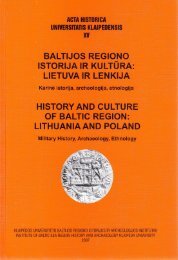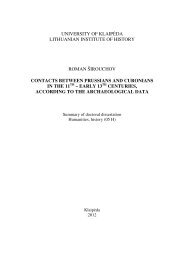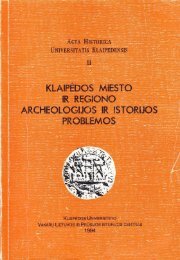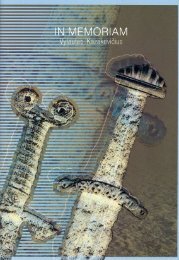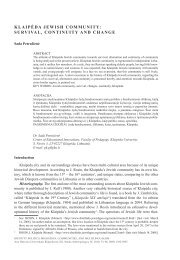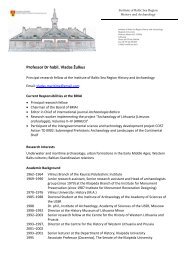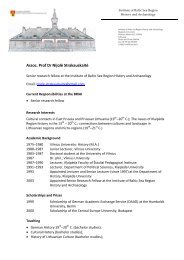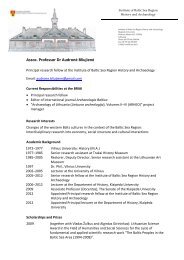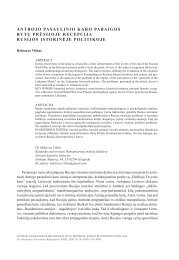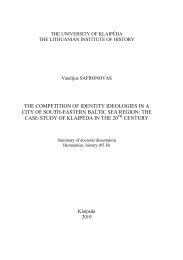See summary of dissertation in English - Baltijos regiono istorijos ir ...
See summary of dissertation in English - Baltijos regiono istorijos ir ...
See summary of dissertation in English - Baltijos regiono istorijos ir ...
You also want an ePaper? Increase the reach of your titles
YUMPU automatically turns print PDFs into web optimized ePapers that Google loves.
nor other natural water bodies could provide stable or considerably larger<br />
revenues at that time. For that reason the practice <strong>of</strong> fish<strong>in</strong>g <strong>in</strong> natural<br />
water bodies gradually decl<strong>in</strong>ed. The grow<strong>in</strong>g needs <strong>of</strong> that time could<br />
only be satisfied by systematic fish<strong>in</strong>g. Its ma<strong>in</strong> goal was a wholesale<br />
fish supply to the market. Fish were reared <strong>in</strong> ponds, which were mentioned<br />
<strong>in</strong> 11 Samogitian manors (11.3% <strong>of</strong> all the manor <strong>in</strong>ventories under<br />
analysis). Historians believe that the presence <strong>of</strong> more than one pond<br />
at the manor may testify systematic fish farm<strong>in</strong>g. The analysis revealed<br />
that the average <strong>of</strong> around 1.5 ponds fell per one manor, which makes one<br />
pond less than <strong>in</strong> Poland at that time.<br />
Though comparatively scarce <strong>in</strong> number but occasionally welldeveloped<br />
pond systems show that fish breed<strong>in</strong>g, which requ<strong>ir</strong>ed considerable<br />
expertise and efforts, was not only known but actually developed<br />
<strong>in</strong> Samogitia. However, such fish farm<strong>in</strong>g was not affordable<br />
to everyone but the manors <strong>of</strong> the largest economic capacities only.<br />
Beekeep<strong>in</strong>g known s<strong>in</strong>ce the old times was highly appreciated and<br />
even protected by the legal acts <strong>of</strong> the ruler. The lord did not need to<br />
keep bees for a long time, because honey was available at the forest<br />
from wild bees. However, with the grow<strong>in</strong>g demand for bee products<br />
<strong>in</strong> foreign markets, manors became <strong>in</strong>terested <strong>in</strong> beekeep<strong>in</strong>g as well.<br />
The need for these products at Samogitian manors was solved <strong>in</strong> several<br />
ways. In some cases hives were kept <strong>in</strong> the village at the homesteads<br />
<strong>of</strong> those people, who had the right to a portion <strong>of</strong> honey. In<br />
other cases hives could be kept at the manor itself. A strict registration<br />
<strong>of</strong> hives and manor control show that special attention was paid to<br />
manorial beekeep<strong>in</strong>g.<br />
The forest, which was the source <strong>of</strong> raw materials and export revenues,<br />
played an important role <strong>in</strong> the farm<strong>in</strong>g <strong>of</strong> that time as well. It<br />
provided wood for constructions, fuel, meat, fur, honey, mushrooms<br />
and berries. Cattle were pastured <strong>in</strong> forests; forest crafts were also<br />
developed: extraction <strong>of</strong> potash, tar, coal. In the 16 th century, the forest<br />
had already passed over to the legal disposition <strong>of</strong> the manor and it<br />
was subsequently given over to peasants. The sources <strong>of</strong> Samogitian<br />
manors do not <strong>in</strong>clude any data on forest crafts, such as extraction <strong>of</strong><br />
tar, potash or coal. It is most likely that the largest benefit was gener-<br />
34



